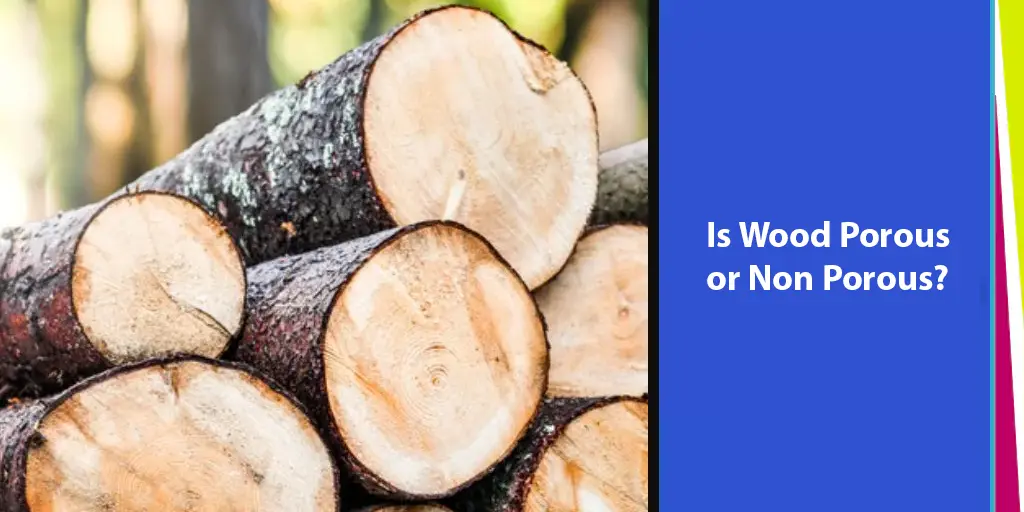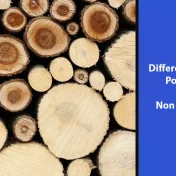Understanding a material’s porous or non-porous nature is crucial to determine how it will perform, age and react to different conditions.
In this comprehensive guide, we’ll examine wood specifically – focusing on what makes it porous, how wood porosity varies, and the effects of porosity on wood’s characteristics and applications.

Wood is a natural material created through the growth of trees. Its cellular structure forms a complex network of pores – making it inherently porous to varying degrees.
Different wood types exhibit their own distinct levels and patterns of porosity due to grain density, cell structure and other factors.
The porosity of wood influences several of its most basic properties. Porous wood absorbs liquids like water and finishes easier, but can also be more vulnerable to damage.
Non-porous wood showcases finishes more evenly but requires more maintenance. As a result, understanding wood porosity helps you select the right wood species suited for different purposes from furniture to flooring to construction.
In this guide, we’ll cover everything you need to know about wood porosity in a clear, straightforward manner.
Through both conceptual explanations and practical examples, we aim to deepen your knowledge of this fundamental material characteristic and how it shapes the usage of wood as a building block of our daily lives.
What is Porosity?
Allow us to define porosity before delving into wood’s porous nature specifically. In materials science, porosity refers to the presence of pores – microscopic empty spaces or holes distributed throughout a material.
Porous materials have a continuous solid structure with interconnected pores, allowing liquids and gases to permeate through them. On the other hand, non-porous or impervious materials lack through pores, rendering them incapable of being penetrated by liquids and gases.
The porosity of a material influences nearly all aspects of its physical and chemical properties. Some notable aspects affected by material porosity include:
- Strength: Porous materials tend to be weaker due to higher surface area, hollow pores and discontinuities.
- Permeability: Porous materials allow fluids to infiltrate and pass through them based on their pore size, distribution and interconnectivity.
- Absorption: Materials with porous structures absorb more liquids depending on the extent of porosity.
- Weight: Porous materials tend to weigh less compared to non-porous counterparts of the same volume due to the presence of empty spaces.
- Durability: Porous materials are more prone to damage from abrasion, chemicals and weathering since fluids can infiltrate pores.
Porosity in Wood
The natural porous structure of wood is a result of its cellular composition. All wood is made of cells – the two main types being vessel and Fiber cells.
Vessel cells form longitudinal tubes running along the grain to transport water and minerals within the tree.
Wood is made porous by the presence of longitudinal pores within the vessel cells, which are essentially empty lumens.
The presence of Fiber cells in wood is crucial for providing a strong and sturdy support system. Fiber cells, although strong, possess micropores within their cell walls.
These micropores add to wood’s overall porosity but to a lesser extent than vessel pores.
Together, vessel and Fiber cells – along with intercellular spaces in between – contribute to a complex network of pores in wood.
The proportion and arrangement of these cell types determine the level of porosity in different wood species.
Hardwoods like oak and ash tend to have wider vessel cells, forming larger pores and higher porosity. They absorb moisture fast but are more prone to damage.
Softwoods, such as pine and fir, have narrower vessel cells, which leads to reduced porosity. They are more resistant to moisture but take longer to dry.
Within hardwoods and softwoods, porosity also varies with density and grain.
Ring-porous hardwoods like oak have large pores only in early wood while smaller pores in latewood lead to uneven permeability.
Maple, a type of diffuse-porous hardwood, displays a remarkably consistent porosity.
Effects of Wood Porosity
As established, wood’s porous cellular structure and varying levels of porosity influence its properties in myriad ways which subsequently determine its suitability for different applications.
Let’s examine the key effects of porosity on wood’s performance:
Strength and Durability
Greater porosity signifies larger and more interconnected pores, creating discontinuities that weaken the wood’s structure. As a result, highly porous woods tend to be less stable and resistant to damage from impact, abrasion and the elements over time.
Moisture Absorption
Higher porosity allows for faster ingress and egress of moisture through wood’s empty spaces.
Porous woods have a higher capacity to absorb finish and motion levels as well as the ability to release them more rapidly. They undergo significant levels of swelling and shrinking motion, resulting in fluctuation.
Wood is lighter than non-porous materials because it contains pores. However, wood density remains the primary factor affecting its weight.
Surface Characteristics
Porosity influences surface characteristics like smoothness and ability to carry finishes evenly. Non-porous wood has smoother surfaces while porous wood showcases uneven gloss or matte depending on pore size and distribution.
Care Requirements
Due to faster moisture absorption and release, porous wood needs more frequent protection from liquids and care. Non-porous wood is less demanding and retains finishes for longer.
In summary, wood’s porosity alters all its inherent properties related to strength, moisture absorption, surface texture and maintenance needs.
In the next sections, we will delve into how different wood types perform in various applications such as furniture, flooring, construction, and more.
Reducing Wood Porosity
While wood’s natural cellular structure makes it inherently porous, various treatments can reduce its porosity to varying degrees. Common methods to minimize pore volume and connectivity in wood include:
Sealing
Surface treatments like varnishes, waxes and resins fill the outer layer of pores by penetrating them.
They form a protective film that inhibits moisture penetration but do not make wood fully non-porous. Reapplication is required for long-term protection.
Filling
Hardening fillers like epoxy and plastic are injected into wood’s pores under pressure. They harden within the pores to form a partially non-porous surface. However, pore filling often changes wood’s appearance.
Wood impregnation is a meticulous process that involves soaking the wood in preservatives. Through the use of vacuum and pressure techniques, these preservatives can effectively penetrate even the deepest pores of the wood.
When chemicals are deposited in pores, they become hardened once they dry. While effective, impregnation alters wood’s original properties the most.
There are pros and cons associated with both porous and non-porous wood:
Porous wood is easier to work with, showcases natural grain and dents/dings less visibly. But it requires frequent maintenance and is less stable dimensionally.
Non-porous wood endures liquids and abrasion better while reducing maintenance needs. However, its lack of pores diminishes wood’s natural feel, affects its ability to breath and changes how finishes are absorbed.
Ultimately, by employing different treatments to reduce the natural porosity of wood, its potential for use in applications requiring superior durability and stability is maximized.
However, a drawback of this approach is that it results in some modifications to the wood’s inherent aesthetics and properties. The right balance depends on the specific end use and performance requirements.
Applications
Wood’s varying levels of porosity make different species suitable for diverse applications, bringing distinct pros and cons to each use case.
Let’s examine some examples:
Furniture
Porous hardwoods like oak and ash provide the natural appearance, character and workability preferred for furniture.
Although they require additional upkeep, they are less prone to noticeable dents and scratches.
The use of non-porous wood enhances the visual attractiveness of furniture, while also providing long-lasting durability benefits.
Flooring
Stable, uniform porosity balancing moisture absorption and release makes maple, beech and birch good flooring choices.
Tropical woods with a higher density and treated pine require less maintenance, but at the cost of their natural appeal. The uniformity and longevity of a floor finish are directly influenced by its porosity.
Construction
Within the constraints of structural integrity, porosity plays an important role. Medium porous softwoods are ideal for non-load bearing elements due to their high workability.
Wood used in load-bearing structures maximizes strength through the use of porous heartwood, while also ensuring dimensional stability by incorporating less porous sapwood. The unique application of non-porous wood is revealed in various fields.
Musical Instruments
Extraordinarily porous woods like spruce and cedar suit soundboards and sounding boards due to vibrational energy transference through those pesky pores. To ensure dimensional stability, winged linings are made with woods that have a lower porosity.
In all applications, the right balance between porous and non-porous wood depends on how well their respective advantages serve material and aesthetic requirements.
In the world of woodworking, it is widely believed that allowing natural porosity to remain by carefully selecting the right wood species is far superior to forcefully combatting it with treatments.
Doing so preserves the essential character and capacity of wood as a living material.
By raising your awareness of porosity’s influence, this article equips you to weigh these considerations consciously when choosing wood for your next project.
By understanding the advantages and disadvantages of wood porosity for various purposes, you can fully explore the range of possibilities that wood offers. This includes using wood as it is or treating it to reduce its pores.
Conclusion
In summary, wood’s inherent porous cellular structure – varying across species and grain patterns – determines its properties, performance, and suitability for diverse applications.
The key takeaways regarding wood porosity include:
- Wood is naturally porous due to its composition of vessel, fibre and parenchyma cells with lumens and micropores between cell walls.
- Higher porosity makes wood more absorbent of liquids but also weaker, less dimensionally stable and more demanding to maintain.
- Choosing the right type of wood based on its natural porosity is usually more effective than trying to change the porosity through treatments.
- Porosity reduction methods are helpful for increasing durability. However, they should be used carefully as a supplement to, rather than a replacement for, choosing a well-matched porous wood.
- Understanding how the porosity of wood affects its properties enables you to fully utilize its potential in various applications, such as furniture, flooring, and musical instruments.
With this confidence, understanding the difference between porous and non-porous wood, as well as the importance of porosity, will help you make better choices for various applications that require the unique qualities of wood.
No material we interact with daily is without intricacies – from texture to strength to lifespan. I hope talking about wood’s porosity has made you interested in learning more about other common materials and appreciating their unique features.



